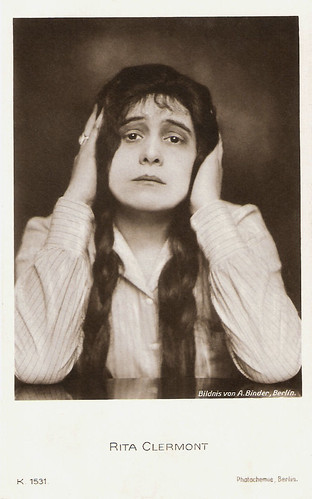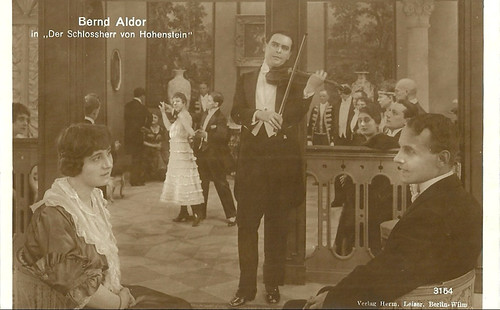
German postcard by Photochemie, Berlin, no. K. 1531. Photo: Alex Binder, Berlin.

German postcard by Photochemie, Berlin, no. K. 1659. Photo: Berliner Illustrations Gesellschaft.

German postcard by Photochemie, Berlin, no. K 1417. Photo: Alex Binder.
Flappers, 'backfisches' and cheerful, rebellious girls
Rita Clermont was born Maria Juliane Forstner in 1894 in Regensburg, German Empire, into a middle-class family.
She became interested in acting at an early age. In 1910 she received acting lessons at the Munich Lustspielhaus from chief director Willy Kissmer, whom she followed in 1911 for her first engagement at the Stadttheater von Landshut. Then she came to the City Theater of Nuremberg and then to the Bremen City Theater. A year later she reached Berlin, where she appeared at the Volksbühne.
In 1915, Oskar Messter discovered her for the film and gave her the leading role in the comedy Fräulein Hochmut/Miss Arrogance (Franz Hofer, 1915). Hofer directed her in a series of similar cheerful stories, in which she mimed flappers, 'backfisches' and cheerful, rebellious girls such as in So'n Rackerchen/Such a rascal (William Karfiol, 1916).
She appeared in the German silent film Das unheimliche Haus/The Uncanny House (Richard Oswald, 1916), a mystery film starring Werner Krauss, Reinhold Schünzel, and Lupu Pick. It was released in three parts. The second part was called Der chinesische Götze/The Chinese idol and the third Freitag, der 13/Friday the 13th.
The following year, she played the female lead in the drama Der Schloßherr von Hohenstein/The Lord of Hohenstein (Richard Oswald, 1917) starring Bernd Aldor, and Lupu Pick. She then appeared in the historical film Nocturno der Liebe/Nocturne of Love (Carl Boese, 1919) that portrays the life of the composer Frederic Chopin (Conrad Veidt).
Veidt was also her co-star in the drama Die Prostitution/Prostitution (Richard Oswald, 1919) which was released in two parts, Das gelbe Haus/The Yellow House and Die sich verkaufen/Those who sell themselves. It was one of several 'Aufklärungsfilme' (enlightenment films), made during the era by Richard Oswald. The physician Magnus Hirschfeld was an advisor on the production.

German postcard by Verlag Hermann Leiser, Berlin, no. 3154. Photo: Richard Oswald-Film. Bernd Aldor playing the violin in the German silent film Der Schloßherr von Hohenstein/The manor of Hohenstein (Richard Oswald, 1917). The woman left in the foreground is Rita Clermont.

German postcard by Verlag Hermann Leiser, Berlin-Wilm., no. 7252.

German postcard by Verlag W.J. Mörlins / Ross Verlag, Berlin, no. 9011/1. (With the logo of Rotophot). Photo: Karl Schenker.

German postcard by NPG, no. 1075. Photo: Anny Eberth, Berlin.
Comedies, melodramas, and also educational films
Rita Clermont acted in very different productions such as comedies, melodramas, and also educational films. When she suffered a serious accident while filming Karl Halden's film Der Shawl der Kaiserin Katherina II/The Shawl of Empress Katherina II (1920), she hit the headlines, but her fame as a screen star began to wane noticeably.
She played in Betrüger des Volkes/Deceiver of the People (Reinhold Schünzel, 1921) starring Charles Willy Kayser. Kayser directed her in Tanz der Leidenschaft/Dance of Passions (Charles Willy Kayser, 1922). She played a supporting part in Irene d'Or/Irene of Gold (Karl Sander, Frederic Zelnik, 1923), starring Margarete Schlegel and Hans Albers.
Finally, she starred in the comedy Maud Rockfellers Wette/Maud Rockefeller's Bet (Erich Eriksen, 1924) with Erich Kaiser-Titz. After 1924 she mended her film career and lived with her husband, factory owner Kurt Hetschingk, whom she had married in 1919.
It was not until the 1940s that she appeared again in front of the camera, reportedly on three experimental programs of the Fernsehsender Paul Nipkow. However, only the participation in the TV film Abenteuer in Petersburg/Adventure in Petersburg (1941) can be proven. Her last screen appearance was in the TV film Grenzgänger/Frontier workers (Ludwig Cremer, 1962).
Rita Clermont passed away in 1969 in Munich, West Germany. She was 75. Her marriage with Kurt Hetschingk was childless.

German postcard by Photochemie, Berlin, no. K. 161. Photo: Alex Binder, Berlin.

German postcard by Photochemie, Berlin, no. K. 162. Photo: Alex Binder, Berlin.

German postcard by Photochemie, Berlin, no. K. 1418. Photo: Alex Binder, Berlin.

German postcard by Photochemie, Berlin, no. K. 1792. Photo: Berliner Illustrations Gesellschaft.
Sources: Stephanie D'heil (Steffi-Line - German), Wikipedia (German and English), and IMDb.
No comments:
Post a Comment